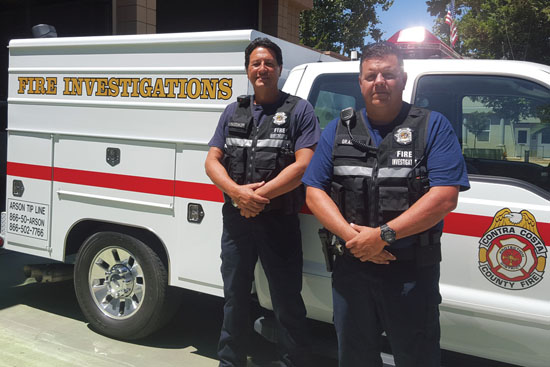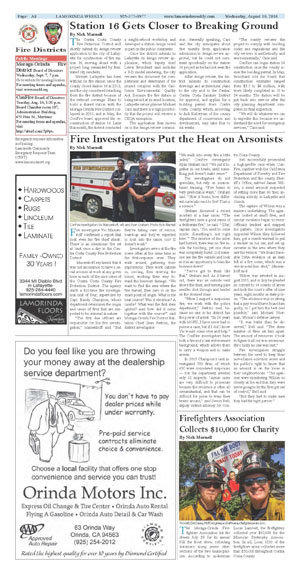| | Published August 10th, 2016
| Fire Investigators Put the Heat on Arsonists
| | | By Nick Marnell |  | | ConFire investigators Vic Massenkoff, left, and Ryan Graham Photo Nick Marnell |
Fire investigator Vic Massenkoff confirmed a report that took even his fire chief aback: There is an intentional fire set at least once a day in the Contra Costa County Fire Protection District.
 Massenkoff explained that it was not uncommon to have a serial arsonist at work at any given time in each of the nine cities of the Contra Costa County Fire Protection District. The agency staffs a full-time fire investigation unit of four, supervised by Capt. Randy Champion, whose department determines the origin and cause of fires that are suspected to be criminal in nature.
Massenkoff explained that it was not uncommon to have a serial arsonist at work at any given time in each of the nine cities of the Contra Costa County Fire Protection District. The agency staffs a full-time fire investigation unit of four, supervised by Capt. Randy Champion, whose department determines the origin and cause of fires that are suspected to be criminal in nature.
 "The first due officers are responsible for the fire investigation," Massenkoff said. "But they're taking care of rescue, board-up and they're expected to look into the cause, too? It doesn't work."
"The first due officers are responsible for the fire investigation," Massenkoff said. "But they're taking care of rescue, board-up and they're expected to look into the cause, too? It doesn't work."
 Investigators arrive at the fire scene often at the same time as the first-response crew. They walk around, gathering their impressions. They work outside in, circling, then entering the house, working their way toward the heaviest damage. "We want to find the area where the fire started, then zero in on the exact point of origin. What is the heat source? Was it electrical? A candle? What was the first item ignited? And how did it come together with the source?" said Moraga-Orinda Fire District Battalion Chief Sean Perkins, the district investigator.
Investigators arrive at the fire scene often at the same time as the first-response crew. They walk around, gathering their impressions. They work outside in, circling, then entering the house, working their way toward the heaviest damage. "We want to find the area where the fire started, then zero in on the exact point of origin. What is the heat source? Was it electrical? A candle? What was the first item ignited? And how did it come together with the source?" said Moraga-Orinda Fire District Battalion Chief Sean Perkins, the district investigator.
 "We walk into every fire a little jaded," ConFire investigator Ryan Graham said. "We put it together in our heads, until something just doesn't make sense."
"We walk into every fire a little jaded," ConFire investigator Ryan Graham said. "We put it together in our heads, until something just doesn't make sense."
 The investigators do not speculate, but rely on science-based training. "Fire burns in very predictable ways," Graham said. "How it burns, how different materials react to fire? That is a science."
The investigators do not speculate, but rely on science-based training. "Fire burns in very predictable ways," Graham said. "How it burns, how different materials react to fire? That is a science."
 Graham discussed a recent incident at a hair salon. "The firefighters have a good sense of a deliberate fire," he said. "(The) captain says, 'You need to come inside. Something's not right here.'" The exterior of the salon had burned, there was no fire inside the building, yet one chair was completely burnt. Did someone see the fire outside and look at it as an opportunity to burn the business down?
Graham discussed a recent incident at a hair salon. "The firefighters have a good sense of a deliberate fire," he said. "(The) captain says, 'You need to come inside. Something's not right here.'" The exterior of the salon had burned, there was no fire inside the building, yet one chair was completely burnt. Did someone see the fire outside and look at it as an opportunity to burn the business down?
 "You've got to think like that," Graham said. As it turned out, there was an outside vent above the chair, and burning pine needles shot through and landed on the doomed chair.
"You've got to think like that," Graham said. As it turned out, there was an outside vent above the chair, and burning pine needles shot through and landed on the doomed chair.
 "When I suspect a suspicious fire, we work with the police department," Perkins said, because no one in his district has the power of arrest. "In 26 years with MOFD, I have never had to pursue a case, but if I did I know Vic would come over and help." The ConFire investigators have both a fire and a law enforcement background, which allows them to carry a weapon and to make arrests.
"When I suspect a suspicious fire, we work with the police department," Perkins said, because no one in his district has the power of arrest. "In 26 years with MOFD, I have never had to pursue a case, but if I did I know Vic would come over and help." The ConFire investigators have both a fire and a law enforcement background, which allows them to carry a weapon and to make arrests.
 In 2015 Champion's unit investigated 729 fires, of which 630 were considered suspicious - but the department arrested only 12 suspects. "Arson cases are very difficult to prosecute because the evidence is often all circumstantial, and that can be difficult for juries to wrap their brains around," said Devon Bell, deputy district attorney for Contra Costa County.
In 2015 Champion's unit investigated 729 fires, of which 630 were considered suspicious - but the department arrested only 12 suspects. "Arson cases are very difficult to prosecute because the evidence is often all circumstantial, and that can be difficult for juries to wrap their brains around," said Devon Bell, deputy district attorney for Contra Costa County.
 Bell successfully prosecuted a high-profile case when ConFire, together with the California Department of Forestry and Fire Protection and the county Sheriff's Office, nabbed James Wilson, a serial arsonist suspected of setting more than 60 fires, including activity in Lafayette and Orinda.
Bell successfully prosecuted a high-profile case when ConFire, together with the California Department of Forestry and Fire Protection and the county Sheriff's Office, nabbed James Wilson, a serial arsonist suspected of setting more than 60 fires, including activity in Lafayette and Orinda.
 The capture of Wilson was a massive undertaking. The agencies looked at small fires, and similar incidents began to recur. Officials tracked and mapped the pattern. Once investigators suspected Wilson they followed him, got a search warrant to put a tracker on his car, and set up cameras in the area where they saw his vehicle. "We found traceable DNA evidence on an item left at a fire scene, which was a one-in-a-million shot," Massenkoff said.
The capture of Wilson was a massive undertaking. The agencies looked at small fires, and similar incidents began to recur. Officials tracked and mapped the pattern. Once investigators suspected Wilson they followed him, got a search warrant to put a tracker on his car, and set up cameras in the area where they saw his vehicle. "We found traceable DNA evidence on an item left at a fire scene, which was a one-in-a-million shot," Massenkoff said.
 Wilson was arrested in August 2015, and in July he pleaded no contest to 14 counts of arson and took the court's offer of nine years, eight months in state prison. "The evidence was so strong that a jury would have found him guilty, so I got him the best deal possible," said Michael Thorman, Wilson's defense lawyer.
Wilson was arrested in August 2015, and in July he pleaded no contest to 14 counts of arson and took the court's offer of nine years, eight months in state prison. "The evidence was so strong that a jury would have found him guilty, so I got him the best deal possible," said Michael Thorman, Wilson's defense lawyer.
 "It was better than he deserved," Bell said. "The sheer number of fires set him apart. The amount of resources it took to figure it all out was enormous. He's lucky no one was hurt."
"It was better than he deserved," Bell said. "The sheer number of fires set him apart. The amount of resources it took to figure it all out was enormous. He's lucky no one was hurt."
 Fire investigators struggle between the need to keep their surveillance activities secret and the public's right to know that an arsonist is on the loose in their neighborhoods. "The agencies were monitoring Wilson so closely at the end that they were never going to let the fires get out of control," Bell said.
Fire investigators struggle between the need to keep their surveillance activities secret and the public's right to know that an arsonist is on the loose in their neighborhoods. "The agencies were monitoring Wilson so closely at the end that they were never going to let the fires get out of control," Bell said.
 "But they had to make sure they had the right person."
"But they had to make sure they had the right person."

|
| | | | | | | | | | | | |



